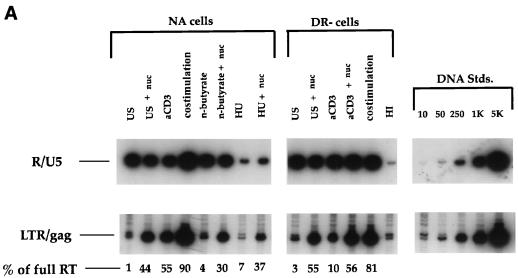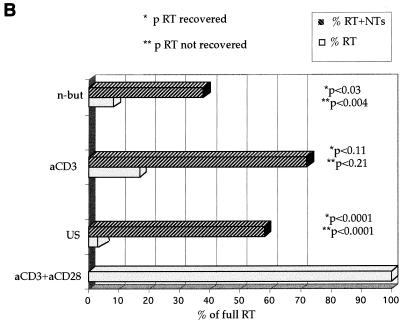FIG. 1.
(A) Effect of exogenous nucleosides on HIV reverse transcription. Cells treated as indicated were infected with NL4-3 in the presence or absence of 10 μM of deoxynucleosides (nuc) per ml. US, unstimulated cells; αCD3, cells stimulated with αCD3 alone; costimulation, cells stimulated with αCD3 and αCD28; n-butyrate, costimulated cells treated with n-butyrate prior to costimulation; HU, costimulated cells treated with HU prior to costimulation; HI, cells infected with a heat-inactivated virus, as a negative control for reverse transcription; RT, reverse transcripts. At 17 h postinfection, DNA was harvested and subjected to quantitative PCR with the primer pairs for the R and U5 regions and the LTR and gag regions to detect initiation and completion of the HIV-1 reverse transcription process. Quantitative standards (Stds.) for 10 to 5,000 copies of viral DNA amplified in parallel are shown on the right. (B) Statistical analysis to assess the significance of the nucleoside-induced rescue of the reverse transcription process. The data are compiled from seven experiments to assess the effect of nucleoside addition on amounts of complete reverse transcripts in infected cells arrested in the G0 (US [for unstimulated]) or G1a (αCD3 and n-but [for n-butyrate]) phase of the cell cycle, compared to that on fully activated cells (αCD3+αCD28). *p, P values for the significance of the level of reverse transcripts (RT) recovered compared to the level recovered in cells without nucleoside addition; **p, P values for the significance of the level of reverse transcripts not recovered in nucleotide (NT)-treated cells compared to the level not recovered in the costimulated control cells.


